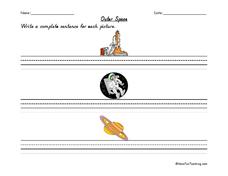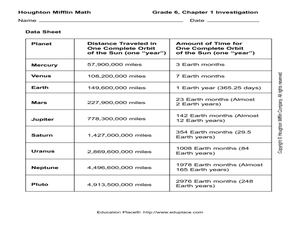Curated OER
Destination Outer Space
Students investigate space travel. In this space travel lesson students examine space exploration history, engineers and scientists involved in space exploration, and Newton's third law of motion. Students make rockets.
Curated OER
Food for Spaceflight
When astronauts get hungry in outer space, they can't just call and have a pizza delivered. In order to gain an appreciation for the challenges associated with space travel, young learners are given the task of selecting, testing, and...
Curated OER
Summer Bridge Activities
Youngsters start by writing a story about going to outer space. They then solve math word problems, match words to their correct meaning by using a dictionary, solve multiplication and division problems, and add the correct prefixes and...
Curated OER
Get a Leg Up
Traveling through space is an amazing experience, but it definitely takes a toll on the body. After reading an article and watching a brief video, learners perform an experiment that simulates the effects of zero gravity on the human body.
K5 Learning
Space Based Astronomy
How much astronomy can you study with the naked eye? Learn more about the ways scientists explore the galaxy with a short reading passage and set of short-answer questions.
Curated OER
Outer Space
In this space worksheet, students write a sentence for each picture. The pictures show a space shuttle, an astronaut, and a planet.
Curated OER
Moon Mining
Go on a moon mining expedition from the safety of your classroom with this space exploration simulation. Using simple models of the moon's surface prepared ahead of time by the teacher, young scientists are challenged with locating and...
Curated OER
SALLY RIDE
Students express what it would be like to launch off into outer space in a space shuttle. They include what it might feel like, look like, sound like, and any thoughts that go through their mind as they dart away from the Earth's...
Alabama Learning Exchange
The Strength of the Sun
Students explore the sun and take a "trip" to outer space.
Curated OER
Grade 6 Math Investigation
In this math investigation worksheet, students find five facts about outer space that contain a number greater then ten million, underlining the digit in the ten millions place. Worksheet has a chart with facts beyond the 10 million place.
Curated OER
Scale Model of the Solar System
Young scientists gain a better understanding of space, the solar system and its vastness by creating a scale model. Students first need to calculate the distance between each of the nine planets according to the size of their scale. This...
Voyage Solar System
Round and Round We Go — Exploring Orbits in the Solar System
Math and science come together in this cross-curricular astronomy lesson plan on planetary motion. Starting off with a hands-on activity that engages the class in exploring the geometry of circles and ellipses, this lesson plan then...
NASA
Let's Investigate Mars
Take your science class on a hypothetical field trip to Mars with an engaging astronomy instructional activity. After first learning about NASA's Mars rover missions, young scientists plan their own scientific investigations of Earth's...
Curated OER
10 More or 10 Less
Practice adding and subtracting 10 with this outer space worksheet. On the top, scholars match digits floating in stars with sums inside a spaceship. Next, they do the same with subtracting 10, connecting numbers to differences. These...
Curated OER
Decoding a Mystery Message from Space
Students examine a message sent from outer space and do their best to interpret its meaning. In this problem solving lesson, students investigate a code sent to them from "outer space." The students collaborate with their classmates to...
Curated OER
Making Regolith
You may not be able to take a field trip to the moon, but that doesn't mean your class can't study moon rocks. Using graham crackers as the moon's bedrock and powdered donuts as micrometeorites, young scientists simulate the creation of...
Curated OER
The Webb Space Telescope: Detecting Dwarf Planets
In this detecting dwarf planets worksheet, high schoolers read about the Webb Space Telescope that will be launched in 2014 to detect dwarf planets using an infrared telescope. Students solve 3 problems and create a graph for each using...
Curated OER
Embrace Space
Students use the internet to gather informatino about the solar system and space. In groups, they create a slideshow in which they use illustrations from the internet and include their own text. They complete the activity by going on a...
Curated OER
The Drake Equation
Students use the Drake Equation to calculate the probability of sustaining life on various planets. Through the use of the equation, they determine whether intelligent and advanced civilizations can be developed on planets other than...
Curated OER
A Distant View
Students investigate the essential concepts of how lenses work to magnify vision, and then build simple telescopes to demonstrate their understanding. They write a description of how their telescope could be improved and how it works.
Curated OER
Using Coordinate Geometry by Land, Sea and Outer Space.
Students complete a table of values and plot points, as well as construct a graph on a coordinate grid. They construct two graphs on the same coordinate system, and identify the point of intersection. Students represent and record...
Alabama Learning Exchange
Inner and Outer Planets
Students explore the solar system. In this planets lesson, students learn about the other planets in the solar system. They watch a video clip from National Geographic on the solar system, compare and contrast the planets and create a...
Curated OER
Lesson New Museum: Exploring the Building
Explore the possibilities of buildings, public spaces, and architectural design. Learners examine the work of SANAA architects Sejima & Nishizawa through background information, images, and guided class discussion. This lesson...
Laboratory for Atmospheric and Space Physics
Where Are We Going?
Come take a ride on the space bus! Scholars go on an imaginary trip to pick up their peers from the inner and outer planets while reinforcing math skills. First, learners round decimals to identify each planets' distance from Earth....

























